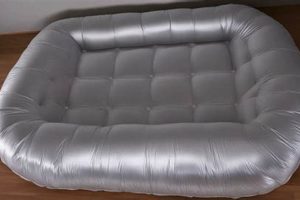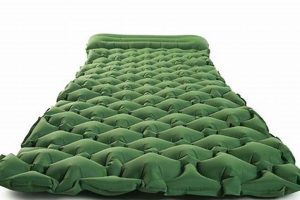The sudden failure of an inflatable sleeping surface, characterized by a sharp sound and immediate loss of air pressure, often results from material stress or puncture. An instance of this would be a mattress deflating rapidly during use due to a seam separating under pressure.
Understanding the mechanics of this failure is crucial for manufacturers to improve product durability and for consumers to make informed purchasing decisions. Addressing common causes, such as over-inflation or exposure to sharp objects, can extend the lifespan of these products and enhance user safety. Furthermore, the history of inflatable sleeping solutions highlights the continuous efforts to refine materials and construction techniques to minimize such occurrences.
This exploration will delve into the primary factors contributing to structural weaknesses in inflatable mattresses, examine methods for prevention and repair, and discuss considerations for selecting higher-quality alternatives. Understanding these aspects can lead to increased user satisfaction and reduced product waste.
Mitigating the Risk of Inflatable Mattress Failure
The following guidelines offer strategies to minimize the likelihood of sudden inflatable mattress deflation, extending product lifespan and ensuring uninterrupted use.
Tip 1: Adhere to Inflation Recommendations: Over-inflation places undue stress on seams and material, increasing the risk of a rupture. Consult the manufacturer’s instructions and use a pressure gauge for accurate inflation.
Tip 2: Protect from Punctures: Sharp objects, including pet claws, can compromise the integrity of the mattress. Use a protective barrier, such as a blanket or fitted sheet, to prevent punctures.
Tip 3: Avoid Extreme Temperatures: High heat or freezing conditions can weaken the material. Store and use the mattress in a temperature-controlled environment to maintain its structural integrity.
Tip 4: Distribute Weight Evenly: Concentrated pressure in a single area can strain the mattress. Distribute weight uniformly by avoiding sitting or kneeling in one spot for extended periods.
Tip 5: Inspect Regularly for Wear: Periodically examine the mattress for signs of wear, such as bulging seams or thinning material. Early detection can allow for timely repairs or replacement, preventing catastrophic failure.
Tip 6: Utilize Proper Storage Techniques: When not in use, deflate and fold the mattress according to the manufacturer’s instructions. Store it in a dry, cool place away from direct sunlight to prevent material degradation.
Implementing these preventive measures can significantly reduce the incidence of unexpected inflatable mattress deflation, providing a more reliable and comfortable sleeping experience.
Following this guidance will allow for greater utility and longevity of the product.
1. Over-inflation
Over-inflation stands as a primary cause of structural failure in inflatable mattresses, leading to rapid air expulsion. The following points delineate the relationship between internal pressure and product integrity.
- Exceeding Pressure Thresholds
Inflatable mattresses possess a designated maximum pressure tolerance. When this threshold is surpassed, the material undergoes stress beyond its elastic capacity. This compromises the structural integrity of the mattress, predisposing it to rupture.
- Seam Stress Amplification
Seams, the joined areas of the mattress material, are inherently weaker points. Over-inflation concentrates stress along these seams, increasing the likelihood of separation or bursting. The result is a sudden release of air, rendering the mattress unusable.
- Material Expansion Limits
The materials used in inflatable mattresses, typically PVC or similar polymers, have a limited capacity for expansion. Beyond this limit, the material becomes brittle and prone to cracking or tearing, precipitating a failure event.
- Compromised Internal Baffles
Internal baffles, which maintain mattress shape and distribute weight, are also susceptible to over-inflation. Excessive pressure can cause these baffles to rupture or detach, leading to uneven support and eventual disintegration of the mattress structure.
The convergence of these factors underscores the critical importance of adhering to manufacturer-recommended inflation levels. Exceeding these parameters significantly elevates the risk of catastrophic failure, ultimately diminishing the lifespan and utility of the inflatable mattress.
2. Material Fatigue
Material fatigue, the progressive and localized structural damage that occurs when a material is subjected to cyclic loading, represents a significant contributor to the failure of inflatable mattresses. Repeated inflation and deflation, combined with the stresses of use, gradually weaken the mattress material, predisposing it to rupture and subsequent air loss.
- Polymer Chain Degradation
The primary materials in inflatable mattresses, typically PVC or thermoplastic polyurethane (TPU), are subject to polymer chain scission under repeated stress. This degradation weakens the material matrix, reducing its tensile strength and elasticity. For example, continuous folding and unfolding of the mattress during storage can create micro-cracks that propagate over time, culminating in a macroscopic failure.
- Plasticizer Loss
Many inflatable mattress materials incorporate plasticizers to enhance flexibility and pliability. Over time, these plasticizers can leach out due to environmental factors like temperature and humidity, rendering the material brittle and susceptible to cracking. This is analogous to the hardening of rubber products exposed to prolonged UV radiation, significantly reducing their ability to withstand pressure.
- Creep and Stress Relaxation
Inflatable mattresses experience continuous stress from internal air pressure. This prolonged stress induces creep, a slow and permanent deformation of the material. Simultaneously, stress relaxation occurs as the material gradually loses its ability to maintain its initial tension. The combined effect weakens the structural integrity, increasing the risk of seam separation or material bursting under normal use conditions.
- Abrasive Wear
Friction against flooring or bedding surfaces can contribute to abrasive wear, thinning the mattress material in localized areas. This thinning reduces the material’s resistance to internal pressure, creating weak points that are prone to rupture. For instance, placing an inflatable mattress on a rough surface without a protective barrier can accelerate abrasive wear, significantly shortening its lifespan.
The cumulative effect of polymer chain degradation, plasticizer loss, creep, stress relaxation, and abrasive wear drastically diminishes the performance and durability of inflatable mattresses. Mitigating these factors through material selection, design optimization, and user care practices can significantly extend the product’s lifespan and reduce the incidence of structural failure, resulting in extended usability.
3. Seam Weakness
Seam weakness is a critical vulnerability in inflatable mattresses, often acting as a primary point of failure leading to sudden and complete deflation. The integrity of these seams directly dictates the mattress’s ability to contain pressurized air, making seam construction and durability paramount.
- Adhesive Degradation
Many inflatable mattresses rely on adhesives to bond separate material layers at the seams. Over time, these adhesives can degrade due to factors like temperature fluctuations, humidity, and material stress. This degradation weakens the bond, creating pathways for air leakage and increasing the likelihood of seam separation under pressure. For example, prolonged storage in a hot attic can accelerate adhesive breakdown, resulting in a compromised seam.
- Welding Imperfections
Heat welding is another common method for creating seams in inflatable mattresses. Imperfect welding techniques, such as insufficient heat application or uneven pressure distribution, can produce weak or incomplete bonds. These imperfections act as stress concentrators, making the seam susceptible to tearing or separation, particularly under the strain of inflation and use. An example is inconsistent weld thickness, leading to localized failures.
- Material Incompatibility
The use of incompatible materials in seam construction can also lead to weakness. If the materials being joined have differing expansion and contraction rates in response to temperature changes, the resulting stress can weaken the bond over time. This is akin to using dissimilar metals in a structural joint, leading to galvanic corrosion and eventual failure. The incompatibility creates a point of weakness that is prone to rupture under pressure.
- Design Flaws
Seam design itself can contribute to weakness. Sharp corners or abrupt transitions in seam geometry can create stress concentrations, making the area more vulnerable to failure. A well-designed seam will distribute stress evenly along its length, minimizing the risk of localized failure. For example, a poorly designed corner seam may experience significantly higher stress than a straight seam, predisposing it to rupture. The design should take into account pressure and material limitations.
The interplay of adhesive degradation, welding imperfections, material incompatibility, and design flaws directly impacts the overall durability of inflatable mattresses. Addressing these factors through improved materials, refined manufacturing processes, and optimized design considerations is essential to mitigating seam weakness and preventing instances of sudden deflation. A focus on seam integrity can significantly enhance the reliability and longevity of inflatable sleeping surfaces, improving the overall user experience.
4. Puncture hazards
The integrity of an inflatable mattress is directly and negatively impacted by puncture hazards. These hazards, encompassing sharp objects or abrasive surfaces, compromise the air-retention capabilities of the mattress, often leading to rapid and complete deflation. The material used in these mattresses, while generally resilient, possesses inherent vulnerability to penetration by pointed items or sustained friction, thus creating a direct causal link to structural failure and the phenomenon of air mattress popping. A common example involves the inadvertent contact of the mattress with a pet’s claws, resulting in a small but critical breach of the air chamber. Such incidents underscore the importance of identifying and mitigating potential puncture sources to prolong mattress lifespan.
The significance of puncture prevention extends beyond simple avoidance. Implementing protective measures, such as utilizing a thick mattress cover or placing the mattress on a smooth, debris-free surface, serves as a practical application of understanding the relationship between external threats and product durability. In environments where complete elimination of hazards is infeasible, reinforcing the mattress’s protective barrier becomes critical. Field studies have demonstrated a marked reduction in deflation incidents when such preventative measures are consistently employed, solidifying the direct correlation between hazard mitigation and product longevity. In the example of camping, the use of a groundsheet or protective tarp under the mattress minimizes the risk of punctures from rocks or thorns.
In conclusion, the understanding of puncture hazards represents a crucial element in maintaining the functionality and longevity of inflatable mattresses. While complete elimination of all potential threats may be unattainable, proactive identification and mitigation strategies substantially reduce the risk of sudden mattress failure. This knowledge is not only vital for consumers seeking to extend the life of their purchases but also for manufacturers aiming to enhance product design and provide clear usage guidelines. The challenge lies in consistently implementing these preventative measures, ensuring a more reliable and comfortable sleeping experience.
5. Weight distribution
Uneven weight distribution across an inflatable mattress concentrates stress on specific areas, significantly elevating the risk of structural failure and subsequent deflation. This phenomenon occurs when a disproportionate amount of weight is supported by a localized region of the mattress, exceeding its design limitations and compromising its integrity.
- Localized Stress Concentration
When a large portion of the weight is focused on a small area, the internal pressure within that region increases substantially. This localized stress concentration can strain the material beyond its elastic limit, leading to micro-tears or seam separation. An example includes repeatedly sitting on the edge of the mattress, which over time weakens the perimeter seams and internal baffles. Such concentrated stress can trigger a rapid loss of air and structural integrity.
- Compromised Baffle System
Inflatable mattresses utilize internal baffles to distribute weight evenly and maintain their shape. Uneven weight distribution can overwhelm these baffles, causing them to deform or rupture. A scenario where one person sleeps consistently in the same position on the mattress creates an imbalanced load, potentially damaging the baffles and creating areas of sagging or bulging. This localized deformation weakens the overall structure and increases the risk of failure.
- Seam Overload
Seams, where different sections of the mattress material are joined, represent inherent weak points. Uneven weight distribution amplifies the stress on these seams, accelerating their degrada
tion. The seams may separate or burst under the increased pressure. For example, placing heavy objects on a specific part of the mattress for extended periods can strain the underlying seams, leading to air leakage and eventual structural collapse. This results in uneven support and potential for rapid deflation. - Material Fatigue Acceleration
Localized stress due to uneven weight distribution accelerates material fatigue. The continuous stretching and compression of the material in the high-stress areas cause microscopic damage, reducing its elasticity and resilience. This fatigue increases the likelihood of tears or punctures, even from relatively minor external factors. The mattress material may also become more susceptible to degradation from temperature changes or UV exposure. The result is a localized point of failure leading to a rapid loss of air.
These factors highlight the crucial role of proper weight distribution in maintaining the structural integrity of inflatable mattresses. By ensuring weight is evenly distributed across the surface, users can minimize localized stress concentrations, protect the baffle system, reduce seam overload, and slow material fatigue, thereby extending the mattress’s lifespan and preventing instances of sudden deflation. The key lies in understanding these mechanical principles and adopting usage habits that promote even weight distribution.
6. Temperature extremes
Temperature extremes exert significant influence on the structural integrity and longevity of inflatable mattresses, frequently contributing to unexpected failures. Exposure to high or low temperatures can alter the physical properties of the mattress materials, predisposing them to compromise and subsequent deflation.
- Elevated Temperatures and Material Softening
Exposure to elevated temperatures, particularly exceeding the manufacturer’s specified limits, causes the polymers used in inflatable mattresses (typically PVC or TPU) to soften. This softening reduces the material’s tensile strength and elasticity, rendering it more susceptible to stretching and tearing under pressure. For instance, storing an inflatable mattress in a hot attic or inside a vehicle on a sunny day can lead to significant material weakening and increased risk of seam failure or rupture.
- Low Temperatures and Material Embrittlement
Conversely, low temperatures can cause the mattress material to become brittle and less flexible. This embrittlement increases the likelihood of cracking, especially when the mattress is folded or subjected to physical stress. Using an inflatable mattress in sub-freezing conditions without proper insulation can result in the material becoming rigid and prone to cracking when inflated or deflated. Repeated exposure to such conditions exacerbates this effect, leading to eventual failure.
- Thermal Expansion and Contraction Stress
Fluctuations in temperature induce thermal expansion and contraction of the mattress material. This cyclical stress weakens seams and bonds over time. If an inflatable mattress is repeatedly moved between warm and cold environments, the constant expansion and contraction place undue strain on the seams, causing them to separate or weaken. This effect is more pronounced in mattresses constructed with materials that have significantly different coefficients of thermal expansion.
- Plasticizer Migration at High Temperatures
Many inflatable mattress materials incorporate plasticizers to enhance flexibility. However, elevated temperatures accelerate the migration of these plasticizers out of the material matrix, resulting in reduced flexibility and increased brittleness. This loss of plasticizers makes the mattress more susceptible to cracking and tearing, particularly at stress points such as seams and corners. Consequently, mattresses exposed to prolonged high temperatures exhibit a reduced lifespan and an increased likelihood of failure.
The influence of temperature extremes on inflatable mattresses underscores the importance of adhering to manufacturer recommendations regarding storage and usage conditions. Avoiding prolonged exposure to both high and low temperatures minimizes the risk of material degradation and structural failure, ultimately extending the lifespan and enhancing the reliability of these inflatable sleeping surfaces.
7. Improper Storage
Improper storage of inflatable mattresses significantly contributes to their premature failure, increasing the likelihood of sudden deflation. Incorrect storage practices can induce material degradation, seam weakening, and overall structural compromise, resulting in a shortened lifespan and a higher incidence of air mattress popping during subsequent use. Adhering to recommended storage guidelines is therefore crucial for preserving mattress integrity.
- Compression-Induced Damage
Storing an inflatable mattress in a tightly compressed state for extended periods can lead to permanent deformation and material fatigue. Constant pressure on folded areas weakens the material fibers and seams, predisposing them to rupture upon reinflation. For instance, packing a mattress into a storage bag that is too small or stacking heavy items on top of it creates excessive stress points, significantly shortening its usable life and increasing the chance of deflation during use.
- Environmental Exposure
Storage environments characterized by extreme temperatures, humidity, or direct sunlight accelerate material degradation. High heat can soften PVC, while low temperatures may cause it to become brittle and crack. Humidity fosters mold and mildew growth, which can damage the mattress material. Direct sunlight, specifically ultraviolet radiation, degrades the polymer structure, leading to weakened seams and increased susceptibility to punctures. Storing a mattress in an uninsulated attic or damp basement will exponentially increase the risk of material failure and air loss when the mattress is later used.
- Puncture Risk During Storage
Improper storage practices increase the risk of punctures and abrasions. Storing the mattress near sharp objects or on rough surfaces without adequate protection can lead to breaches in the air chamber. For example, leaving the mattress in a garage where it can come into contact with tools or storing it on a concrete floor without a protective barrier significantly increases the likelihood of accidental punctures or abrasive wear, resulting in eventual air leakage and deflation.
- Incorrect Folding Techniques
Improper folding techniques can create sharp creases and stress points in the mattress material, leading to localized weakening. Repeatedly folding the mattress along the same lines creates permanent stress, causing the material to fatigue and become more prone to tearing. Folding the mattress too tightly can also put undue pressure on the seams, increasing the likelihood of separation. Following the manufacturer’s recommended folding instructions is therefore critical for minimizing stress and preserving the integrity of the mattress during storage.
The consequences of improper storage practices extend beyond mere inconvenience. By understanding the mechanisms through which incorrect storage degrades mattress integrity, users can
take proactive measures to prolong product lifespan and minimize the occurrence of sudden deflation. Proper storage significantly reduces the likelihood of encountering structural failures, making proper storage vital for maintaining the long-term functionality and reliability of the inflatable sleeping surface.
Frequently Asked Questions
The following addresses common inquiries regarding the sudden and often unexpected deflation of inflatable mattresses, offering concise explanations to enhance user understanding and prevent future incidents.
Question 1: What are the most common causes of inflatable mattress failure?
The primary causes include over-inflation, material fatigue, seam weakness, punctures from sharp objects, uneven weight distribution, exposure to extreme temperatures, and improper storage techniques. Each factor contributes to structural compromise and potential air leakage.
Question 2: How can over-inflation lead to mattress deflation?
Exceeding the recommended inflation level places excessive stress on the mattress material and seams, surpassing their design limits. This can result in material stretching, seam separation, or even a burst, leading to rapid deflation.
Question 3: How does material fatigue contribute to inflatable mattress failure?
Repeated inflation and deflation, coupled with the stresses of use, gradually weaken the mattress material. This fatigue reduces the material’s elasticity and resilience, making it more susceptible to tears and punctures, particularly at stress points.
Question 4: What role do seams play in the durability of an inflatable mattress?
Seams represent inherent weak points in inflatable mattresses. Poorly constructed seams, adhesive degradation, or material incompatibility at the seams can lead to air leakage or seam separation under pressure, resulting in mattress failure.
Question 5: How can users prevent punctures and extend the life of inflatable mattresses?
Preventative measures include using a mattress protector, placing the mattress on a smooth, debris-free surface, and avoiding contact with sharp objects. Regular inspection for signs of wear and tear also aids in early detection and prevention of failures.
Question 6: Why is proper storage important for inflatable mattresses?
Improper storage, such as tightly compressing the mattress or exposing it to extreme temperatures or humidity, can accelerate material degradation and weaken seams. Proper storage involves deflating the mattress completely, folding it loosely, and storing it in a cool, dry environment, away from direct sunlight and sharp objects.
Understanding these factors and implementing preventative measures can significantly extend the lifespan of inflatable mattresses and reduce the likelihood of unexpected deflation.
The subsequent section will explore specific diagnostic techniques to identify the root cause of a failed inflatable mattress.
air mattress popping
The preceding analysis has illuminated the multifaceted causes of structural compromise in inflatable mattresses, culminating in the phenomenon of rapid deflation. Key factors contributing to this event include over-inflation, material fatigue, seam weaknesses, puncture hazards, uneven weight distribution, temperature sensitivities, and improper storage. A comprehensive understanding of these elements is crucial for both manufacturers seeking to enhance product durability and consumers aiming to prolong the lifespan of their inflatable sleeping solutions.
Acknowledging the inherent vulnerabilities of inflatable mattresses and implementing proactive preventative measures represents a necessary step in mitigating the risk of unexpected failure. Continued research and development efforts focused on material science and improved construction techniques hold the potential to significantly reduce the incidence of this problem in future generations of inflatable sleeping surfaces. Therefore, prioritizing responsible usage and informed purchasing decisions remains paramount for ensuring user satisfaction and minimizing product waste.







